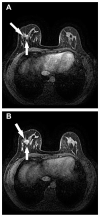Can Magnetic Resonance Imaging Replace Mammography and Ultrasonography for the Detection of Breast Lesions?
- PMID: 32542142
- PMCID: PMC7292694
- DOI: 10.7759/cureus.8087
Can Magnetic Resonance Imaging Replace Mammography and Ultrasonography for the Detection of Breast Lesions?
Abstract
Objective We aimed to evaluate the role of magnetic resonance imaging (MRI) in the visualization of breast lesions and to estimate whether MRI can be a reliable alternative to mammography (MG) and ultrasonography (USG) for this purpose. Materials and methods In this retrospective, single-center study, an analysis of medical files of 260 patients with breast masses as breast imaging reports and data system (BI-RADS) 4 and 5 at MRI was performed. The features of the breast lump, such as the side, location, multi foci or multicentricity, histopathological diagnosis, contrast-enhancement characteristics, radiological, and pathological axillary involvement, were noted. Consistency between MRI-BIRADS and MG+USG-BIRADS, as well as the association between lesion characteristics, was sought. Results The agreement ratio between the BI-RADS categories of MRI and MG+USG was 0.654 while consistency between histopathological diagnosis and MRI BI-RADS category was 0.838. The agreement between the BI-RADS category of MG+USG and histopathological diagnosis was 0.819. The consistency between MRI BI-RADS and MG+USG BI-RADS increased remarkably with the advancement of age. Similarly, the consistency between MRI BI-RADS and histopathological diagnosis tends to increase with the advancement of age. Nonmass contrast enhancement yielded the highest agreement ratios between MRI BI-RADS and MG+USG BI-RADS, histopathological diagnosis and MRI BI-RADS, and histopathological diagnosis and MG+USG BI-RADS. Conclusion Dynamic MRI is a useful and reliable method for imaging breast neoplasms. However, it is not devoid of disadvantages such as cost, attainability, and contrast use and it should be reserved as a problem-solving technique to be used in conjunction with conventional methods including MG and USG.
Keywords: bi-rads; breast tumor; imaging; magnetic resonance imaging; mammography; ultrasonography.
Copyright © 2020, Yilmaz et al.
Conflict of interest statement
The authors have declared that no competing interests exist.
Figures


References
-
- The comparative value of mammographic screening for women 40-49 years old versus women 50-64 years old. Curpen BN, Sickles EA, Sollitto RA, Ominsky SH, Galvin HB, Frankel SD. AJR Am J Roentgenol. 1995;164:1099–1103. - PubMed
-
- Individual and combined effects of age, breast density, and hormone replacement therapy use on the accuracy of screening mammography. Carney PA, Miglioretti DL, Yankaskas BC, et al. https://www.ncbi.nlm.nih.gov/pubmed/12558355. Ann Intern Med. 2003;138:168–175. - PubMed
-
- Likelihood ratios for modern screening mammography. Risk of breast cancer based on age and mammographic interpretation. Kerlikowske K, Grady D, Barclay J, Sickles EA, Ernster V. https://www.ncbi.nlm.nih.gov/pubmed/8667537. JAMA. 1996;276:39–43. - PubMed
-
- Screening mammography reduced morbidity of breast cancer treatment. Leung JWT. AJR Am J Roentgenol. 2005;184:1508–1509. - PubMed
-
- Comparison of the performance of screening mammography, physical examination and breast US and evaluation of factors that influence them: an analysis of 27,825 patient evaluations. Kolb TM, Lichy J, Newhouse JH. Radiology. 2002;225:165–175. - PubMed
LinkOut - more resources
Full Text Sources
